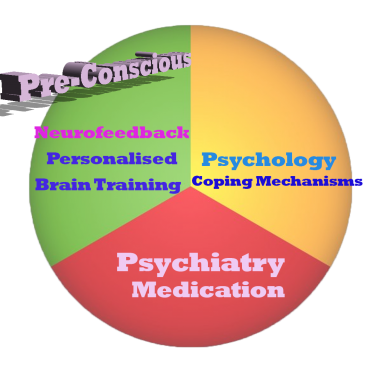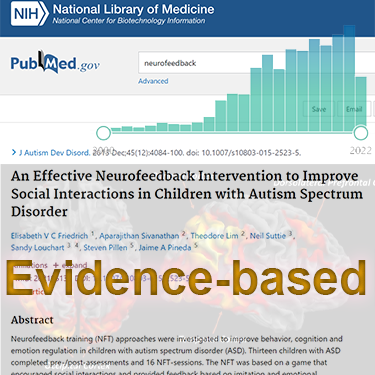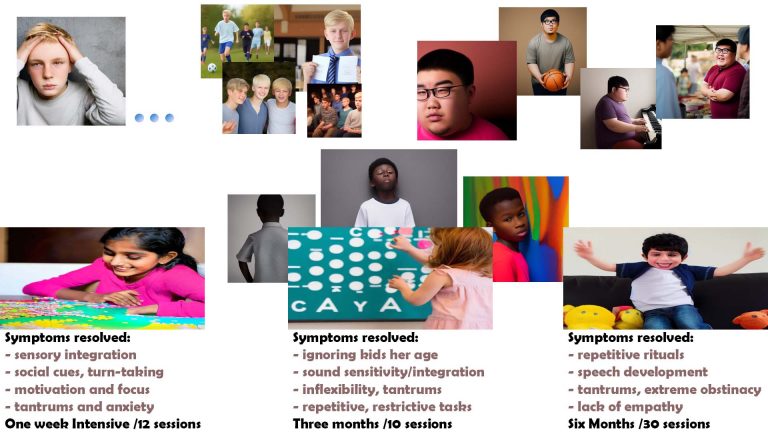Neurofeedback - Pricing
Neurofeedback has been shown to produce fast, lasting effects in a non-invasive, medication-free manner. There is ample scientific literature attesting to this, and its uses include anything to do with the brain. We have seen miraculous transformations achieved in one-week intensives, as well as over a few months of weekly training. This does have a price, and not all neurofeedback is equal. Let’s have a look at what the decision elements are when embarking on a trajectory-changing journey:
Options
First of all, let’s focus on the objective. By the time someone has taken on the effort to research this non-standard, alternative (or better, complementary) approach, many things have not worked out. This can include one, or more, of the following:
– Talk therapy: limited success, reversion of symptoms, feeling of further isolation, high accumulated costs over long periods of time, possible frustration or even worsening of symptoms, heightened self-awareness and loss of direction
– Medication: bothersome side effects, reduced or negative efficacy over time, fears of dependence, increased variety of prescriptions, no obvious path to reduction, persistent or even exacerbated symptoms
– Other holistic treatments: some, but not transformative positive effects; all the way up to exacerbation or new issues
At this point, the person will have spent considerable time, energy and resources, and is left with a feeling of despair that might seem to rival or exceed the initial challenges for which help is sought. Furthermore, there has been an opportunity cost, such as losing valuable time of one’s life to these efforts with possibly little to show for it. What were we trying to achieve in the first place?
Objectives
Therapy of any kind should seek to provide a positive change in trajectory. At the point we seek help, our approach to our environment is not working any longer, and our environment appears hostile and unforthcoming to our desires and needs. We need to change our ability to deal with our surroundings, and ultimately our environment will change – whether perceived or in actuality. It is important to note that there are two components to this:
– How we are equipped to negotiate our friends, family, alliances, workplace, projects and people in general
– Our environment’s suitability to provide sufficient stimulus, encouragement, opportunities and reward



Effects of Neurofeedback
With neurofeedback training, we can influence at least the following; usually, changes in our environment follow quickly as a result, though sometimes this requires further negotiation / coaching:
– Perception: this includes basics, such as sensory integration, and extends to maturity at a higher level, where we are able to see different perspectives, gain a realistic and optimistic understanding of how we ‘fit in’ and can prosper, as well as a healthy detachment from past failures or negative shocks (trauma)
– Cognition: focus, attention, persistence, motivation, effective planning, flexibility and resilience
– Behaviour: turning emotions and urges into pro-social behavior, in a preconscious manner, that is, without having to ‘think about’ or ‘have a word with ourselves’; controlling impulsive aggression (both outward as well as self-directed, i.e. self-harm), rage, emotional hypersensitivity, fears and anxieties; working social rules and boundaries effectively; and inhibitions, or lack thereof
– Physical maturation: structural components, including children’s brain development, to rehabilitation from physical insults such as mTBI, concussion, stroke and other brain damage
Value Creation with Neurofeedback Training
The value created by accelerating each of the above can be viewed in many ways, including:
– Improved functionality: better career advancement, direct earning power enhancement, reduced care costs, increased independence, quality of life, emotional participation and development, social integration, sense of fulfillment
– Economic value added plus intangible, emotional advancement
– Opportunity cost: fast change of trajectory vs years of therapy etc
– Relief to parents / guardians / carers, frees up resources and changes others’ trajectories
– Preservation of dignity – short, non-invasive process requiring minimal conversation – brief intervention instead of protracted, habituating therapy sessions or medication
– Quality of life: speech, communication, reading social emotions, feeling part of something bigger, acceptance, self-other differentiation, intrinsic / pre-conscious understanding of social and personal boundaries, mood and impulse control, focus / attention / motivation / planning / productivity, sleep and restoration, physical rehabilitation, neurodegenerative disease progression [delay] attenuation including symptom relief, improved modeling / predictive skills incl intentions of others, monitoring consequences of actions, sense of self, clarity of mind, feeling grounded, undistracted by worries about reputation or other internal dialogue / intrusive thoughts, hallucination relief, [headache / migraine / epilepsy], improved cortical control of limbic impulses, general flexibility and mental agility

Cost of Neurofeedback - Consumer to Advanced
The cost of neurofeedback training is largely a function of the sophistication of the method used. Not all neurofeedback is the same, and we’ll start with a brief overview of the spectrum of options available:
– Consumer devices: unspecific, one-size-fits-all, low(er) tech, ‘black box’ protocols; note some include NIR or penetration by infra-red light, while termed ‘non-invasive’. Usually state, rather than trait training, emphasising relaxation, meditation-like states, calming and focus. Design limits precision and number of brain areas that can be addressed.
– Elementary devices: supervised by a practitioner; electrodes or ‘cap’ for more specificity with regard to sensor placement, use of computer / tablet for real-time computations, basic visual / auditory feedback method; variable protocols, based on symptom analysis or basic qEEG recording interpretation; state training, attempting trait training. ILF / Othmer Method stands out in this domain; practitioners generally with therapy or psychology background, limited technical understanding, both with regard to programming protocols and understanding the function of individual brain areas / networks.
– Advanced Methods: based on sophisticated qEEG analysis, both with regard to Brodmann area attribution and baseline comparison, revealing character traits and vulnerabilities, rather than more volatile state parameters; audio/visual/tactile feedback method, reliant on accurate electrode placement, trouble-shooting, active clinician participation in continuous threshold setting in-session, personalization and in-session adaptation of protocols, in-person setting, interesting feedback and longer (up to 2.5h) sessions; trait and functional connectivity training. Practitioner should have an in-depth understanding of physiology, or function of brain areas, networks, and EEG. Note that this is a rapidly evolving field and requires research and dedication, rather than simply operating a user interface.
In our experience, the most time- and cost effective method generating lasting results is based on our most advanced method of qEEG interpretation and the in-person training with personalized Default Network Training protocols, developed and implemented by Dr. David Kaiser and Daniel Webster. Results are measurable with re-maps, and cognitive improvements were apparent, as shown in these Case Studies. We were able to achieve trajectory-changing, transformative resolutions and improvements within a week, with intensives, to a few months with weekly training.
Economic and Intangible Effects of Neurofeedback
The cost of neurofeedback training is bounded by the level of clinician and equipment intensity. As this goes up however, the amount of gain in efficacy far outstrips the increase in cost, generally. The value creation by something that works is clearly infinitely more than a method that doesn’t. Quality differences are this large between the spectrum of providers. For lasting, strong results, we are looking for changes in functional connectivity, addressing traits and vulnerabilities, and we have only seen these using advanced methods, and within this rarefied segment, find that our method has been consistent, fast and reliable.
The investment into this relatively short period of therapeutic accompaniment of someone’s life phase can then be viewed in relation with its uplifting consequences:
– School refuser to successful exam completion
– Cessation of panic attacks and anxieties
– Development of friendships and alliances at crucial stages
– Feeling part of something bigger; inclusion
– Regaining sense of self
– Formulation of realistic goals and paths to get there
– Improved productivity, achievement and career progression
– Maturation, flexibility, emotion and mood control
– Sensory integration
– Flexible assertion of personal boundaries
– Effective manipulation of social boundaries and rules
– Appropriate level of monitoring consequences of actions
– Focus, attention and spatial awareness
– Improved motor control and bodily awareness
– Limbic system regulation
– AVH relief
– Inhibition control
– Impulsive aggression, Anger / rage / self-harm management
– Clarity of mind, reduction of internal chatter / intrusive thoughts
– Ability to self-soothe and self-nurture
– Healthy and constructive self-monitoring [dysmorphia management]
– Flexibility to unexpected outcomes
– Improved modeling of environment and intentions of others
– Motivation and reward monitoring
– Risk-taking and confidence
Many of the above improvements we have seen, and are documented in the academic literature as lasting positive consequences of neurofeedback training, translate directly into economic value added. Improved earnings potential, reduced care costs, and freeing up guardians’ resources quickly eclipse the investment made into neurofeedback training.
Intangible consequences, improving quality of life in myriad ways, add to the equation.
How to Choose
We price sessions and training time on a bespoke basis. That said, for comparability, it is important to assert the following when assessing options:
– Realistic training time: We find optimal results within 20-40 hours of neurofeedback time, which amounts to 10-20 of our 3h slot (1.5-2.5h neurofeedback time) sessions. Often, packages are quoted in sessions, most of which are 30-40minutes. On a per hour basis, our prices are extremely competitive, especially given the relative and absolute sophistication of our training methods. While results are unpredictable, we find positive testimonies from the first session, and ten hours, or three sessions often making transformative changes, though we recommend budgeting for at least ten sessions
– Feedback method / bearability: It’s great when training is enjoyable, which ours is – watching a movie of choice, the feedback is largely auditory, with slight and temporary changes in volume. It is not stop-start, and the client wears only 3-5 electrodes at a time, rather than the full cap. This is important to note, as it also facilitates longer sessions where we get to watch an entire feature film.
– Intensity: We aim for fast, transformative results, and have achieved these in week-long intensive courses. Even weekly sessions produce these changes, within a few months, which compares favourably with other interventions. Longer session times facilitate this process, which is a function of the amenability of our training method and protocols, as well as being able to train more and diverse sites. Fewer sessions make the process more accessible to many.
– Location: Daniel Webster provides neurofeedback training both in dedicated practice rooms in the UK and internationally, as well as in-person training at your home.
Daniel Webster's Neurofeedback is Unique
It’s important to note that there are various forms of neurofeedback training. It’s not all the same. A brain map is an important starting point, as this shows us where the issues are. There are different ways to interpret qEEG, and brain maps vary in what they show. The Kaiser Neuromap is the best at showing which functional brain area, or Brodmann area, is dysrhythmic. We then need to be able to interpret this, and form an effective treatment plan. Again, neurofeedback methods vary, and Daniel Webster’s method is the most advanced and effective. It is also the most enjoyable, as it involves watching movies for two hours, in a one-on-one session, and the feedback is subtle, while wearing minimal sensor equipment. It is also genuinely non-invasive, as the only feedback to the brain is through the volume changes.
Daniel Webster offers the most advanced neurofeedback methods as home visits and intensive courses, in the UK and internationally. We generally need 10-20 sessions, each around two hours, and can do these weekly or as an intensive, with two sessions per day for a week. Mood, focus and behavioural issues generally get resolved in 10-20 sessions. Structural issues, such as brain damage or neurodegenerative disorders (Alzheimer’s, MS, Parkinson’s) can take longer or even benefit from ongoing training.



Brain Maps and Personalised Brain Training Explained
Personalised Brain Training with Neurofeedback
Neurofeedback lets us train dysrythmic brain areas. With sensors comfortably fitted to the brain areas we want to train, we detect brainwave patterns real-time while watching a movie. When these patterns are inefficient, the volume drops momentarily. This is the feedback we are giving our brain, short and instantaneously.
The brain area we are training recognises this – while our conscious mind is focussed on the movie – and adjusts its behaviour to restore the normal volume. With repetition, throughout a session, learning occurs.
Meanwhile our conscious mind is solely focussed on the movie; the training process is passive in this sense.
The drop in volume is subtle, so we continue to understand the flow of the movie. No current or electrical stimulation is fed to the brain; sensors simply read brainwaves and the feedback is purely audio-visual.

Neurofeedback trains our Pre-Conscious Mind
Rather than engaging the conscious mind, which slows us down, we are training preconscious processes.
This equips us with the ability to live in the moment and attain our potential (if we have to resort to conscious control, we are not living in the moment).
We take a holistic approach to healthy brain self-regulation, rather than categorisation or diagnosis.
Personalised Brain Training is an advanced qEEG brain map-based approach to neurofeedback training developed by the founders of the field. Taking Othmer Method / ILF training methods further, it employs Default Network Training protocols as developed by David Kaiser.

Neurofeedback is Evidence-based
Neurofeedback training is an evidence-based complementary therapy. Its efficacy was first demonstrated some 50 years ago, and with advances in technology, training protocols have become more efficient and the feedback method – watching movies – thoroughly enjoyable.
Neurofeedback is evidence-based. It’s first application was discovered in 1971 when it was used to resolve intractable epilepsy.
There are over 2,000 peer-reviewed research reports on PubMed demonstrating efficacy across a number of pathologies.
In the US, it is an accepted complementary treatment for many challenges.
Neurofeedback Training Sessions
Personalised Brain Training aims to optimise the cortical connectivity, as well as promoting improved thalamo-cortical connection. Neuroplasticity, the ability of neural networks in the brain to make new connections, is an essential and continuous process that underpins our ability to learn. With brain training, we can promote this process.
Protocols are generally around 30-45 minutes per brain area that we train; as such, training sessions are ideally around 90-120 minutes. This corresponds to the average length of a movie. This is also the length of our ultradian rhythms – attention cycles that govern our day, letting us perform at more than 100% at peak, and less than this at trough – think of the lull we experience around lunchtime. By training the brain throughout a complete cycle, we are more likely to provide the brain with a challenge at different points in its attention cycle for a more comprehensive training.
The primary feedback mechanism in Personalised Brain Training is auditory, that is, a subtle change in volume. The brain recognises this, preconsciously, while our conscious mind is focused on the movie, and corrects its behaviour to preserve the continuity of the watching (or listening) experience. A secondary, visual feedback mechanism can be activated, whereby the picture size changes too, though this is optional in cases of high visual sensitivity (e.g. migraines).
We can track progress by remapping the brain at intervals, usually after every 20 hours of training. Ten sessions will give a good indication of responsiveness, which besides subjective feedback we can ascertain with a further remap. With neurofeedback training, we are showing the brain a more efficient state during a session. Upon repetition, the brain learns to adopt this new state. The person has to then implement this new learning in their life. Internal changes have to be externalised. Training success depends on this ability thus results can vary.
Neurofeedback training begins with two to three sessions per week and the frequency of training can then be adjusted to need and symptom improvements. Intensive courses involving two or more sessions per day can also be accommodated.
Contact Daniel on +44 (0)7966 699430 or neurofeedbackdw@proton.me to arrange sessions.
Neurofeedback is a form of complementary therapy and should not be seen as a replacement for conventional medicine. qEEG brain map-based neurofeedback training takes a more holistic approach to brain functioning, rather than just focusing on medical symptoms. It is not intended as a form of diagnosis nor medical intervention nor medical advice per the disclaimer.

